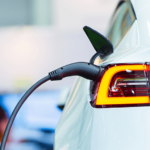
4 Tips for Safely Charging Your Electric Car at Home
With the rise of electric cars, charging has become a talking point with people trying to get the best prices and stay safe. Following on from our last blog about Economy 7 and overnight charging, we’re sharing 4 tips to charge your electric car safely at home.
1. Use a certified charging station installed by a professional
Many can be tempted to use extension leads or workarounds to make their charging cheaper or more convenient. However, electric cars have much more powerful batteries than other lithium-ion battery-powered devices. This means that you could damage your battery and cause a real fire risk by doing this.
You should use a certified charging station which has been installed by a professional. Many homes, especially new-builds, have these ready installed but you can also pay a professional to come and install one at your home.
You should also use the manufacturer's charging cables as they are specially made for your car and may have locking mechanisms and more built-in.
2. Don’t charge your electric car in a garage or carport
Lithium-ion battery fires, while rare, are rapid and ferocious. If you charge your car in your garage or carport, the fire can rapidly spread to your home and other buildings, especially if you are charging it overnight.
If there is a chance that you will not be able to spot any changes or dangers with your car while it is charging, you should try and keep a safe distance between the charging car and your home.
This is the reason that many public and workplace charging stations are located in the far corner of car parks. This keeps any potential risk as far away from buildings and people as possible.
3. Only charge it when you need to – don’t charge it every night
Many of us charge our electric devices every night because that’s what we’re used to and think we should be doing.
This is not the case for electric cars. If your car doesn’t need charging don’t do it ‘just to top it back up’ to full. This can damage the battery and lead to overcharging.
Instead, plan your journeys and charges so that you can ensure that you are charging your electric car when you need to. Your car, and electricity bill, will thank you for it!
4. Follow all guidance and instructions in the manufacturer’s handbook
As we briefly mentioned earlier, you should always use your electric car’s cables and equipment. It is also important to read the guidance and instructions in the manufacturer’s handbook.
We all love to give, and find, advice on the internet – it’s just convenient, isn’t it?
But, a lot of information out there doesn’t apply to all-electric vehicles and may be inaccurate. The most accurate information will always be held in the handbook that comes with your car, that should be treated as the font of all knowledge!
Want to know more about staying safe in the home? Have a look at our other blogs.
The Firechief range includes high-performance fire extinguishers, fire blankets, first aid kits, lithium-ion fire extinguishers and the Kitchen Stove Guard. For more information, call us on +44 (0)330 999 0019 or email sales@firechiefglobal.com.
The information contained within this blog is provided solely for general informational and educational purposes and is not intended as a substitute for professional advice. Before taking any actions based upon this information, we advise the reader to consult any and all relevant statutory or regulatory guidance and where necessary to consult a qualified fire or industry regulation professional. The use or reliance on any information contained herein is solely at the reader’s risk.

